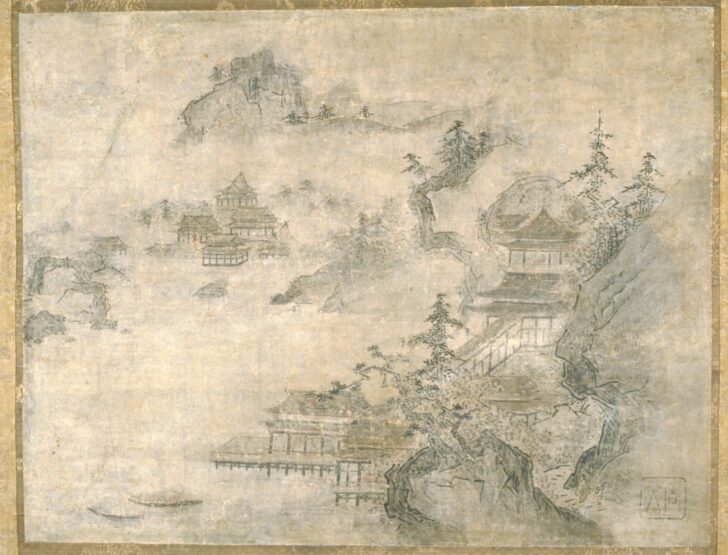Lakeside Temple (Landscape in Shûbun style)
Japanese

Description
One of the distinctive aspects of Zen imagery is the important place granted to landscape as a genre. This is due partly to the historical accident that Zen institutions in China reached their zenith during the Southern Song period (1127–1279), a period when court artists, literati, and monks alike were exploring the expressive possibilities of painting in monochrome ink. China had a long and sophisticated critical tradition that viewed landscape painting as a place of virtual refuge from the “dusty world” of urban life. Landscapes by Chinese monk-painters were eagerly collected and copied in Japan.
In Japanese Zen establishments, ink landscape painting came into vogue only in the fifteenth century, much later than other Zen subjects. The monk-painter Shûbun (active 1423–1460) was the progenitor of a style that dominated the Kyoto market for most of the fifteenth century and survived still longer as a much-sought after ‘brand.” This view of a lakeside temple is a good example of a later work done in Shûbun’s manner. Individual elements—the angular cliffs, the tall pines, the careful delineation of the architecture, and even the amorphous mist—have been extracted from Southern Song paintings. The lack of spatial logic would be troubling to a Chinese critic, but the essence of Shûbun’s approach is its very ambiguity. For Japanese Zen monks and their warrior patrons, ink landscapes in Shûbun’s style evoked an idealized setting for contemplative practice.
Arts of Zen, February 15-June 15, 2003
M. Graybill, Senior Curator of Asian Art
Subject Matter:
This painting depicts a Japanese Zen establishment and an ink-painted landscape. This style of painting, which was one of the most popular styles of painting during the 15th Century, is known known as the Shūnbun style. We know this is Shūbun style because this painting bears the Seal of Shūnbun who was a monk-painter who was active from 1423-1460, and because of the angular cliffs, the tall pines, the careful delineation of the architecture, and even the amorphous mist. His style of painting copies Southern Song Dynasty paintings from China.
Physical Description:
Shown is a complex of temple building on a lakeside. There is a small grouping of buildings on the opposite side of the lake to the left and there is a long building that runs along the right side of the lake with a passage-way to the docks on which is the end of the building. Surrounding the temple complex are pine trees, cliffs, and mist. On the bottom right of the painting is the Seal of Shūbun which lets us know that this is a Shūbun style ink-painting.
Usage Rights:
If you are interested in using an image for a publication, please visit https://umma.umich.edu/request-image/ for more information and to fill out the online Image Rights and Reproductions Request Form.